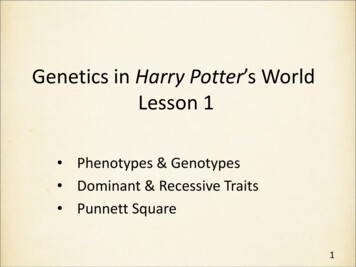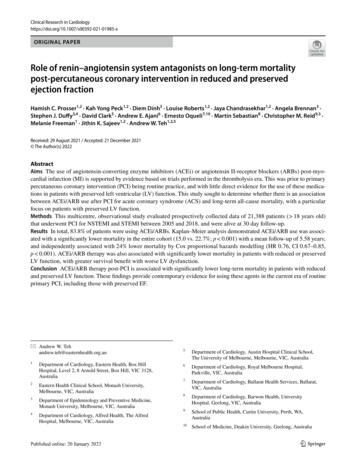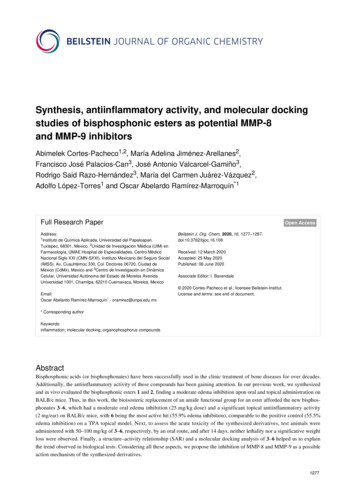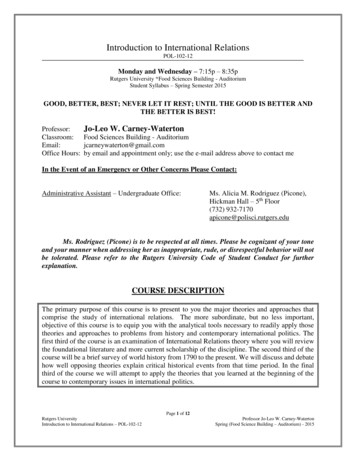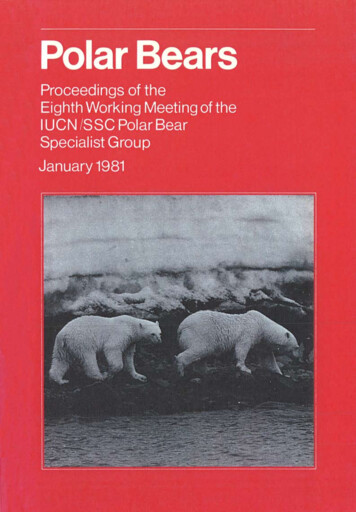
Transcription
POL ARB EAR SProceedings of the Eighth Working Meetingof the IUCN/SSC Polar Bear Specialist GroupHeld at the Ministry of EnvironmentOslo, Norway15-19 January 1981International Union for Conservation of Nature and Natural Resources1196 Gland, Switzerland1985
The op1n10ns expressed in these Papers do not necessarily reflect theviews of IUCN or any other participating organi ation.Copyright1985 IUCNISBN 2-88032-900-0Published by the International Union for Conservation of Nature andNatural Resources (IUCN), 1196 Gland, Swit erland with the financialassistance of the United Nations Environment Programme (UNEP) and theWorld Wildlife Fund (WWF).Available from.IUCN Publications ServicesAvenue du Mont-BlancCH-1196 GlandSwit erlandPrinted in Great Britainat the Cambridge University Press
EIGHTH WORKING MEETING OF POLAR BEAR SPECIALISTSCONTENTSList of Participants5Revised Agenda7Summary of the Meeting8Resolutions.1.Population estimates292.Modelling of polar bear population data293.Polar bear-human interactions304.Development and use of telemetry techniques315.Polar bears and the marine ecosystem of Baffin Bay316.Expression of thanks32Special Statements.1.Statement on Research and the Future Role of thePolar Bear Specialist Group332.The Status and Analysis of Polar Bear Populations.a Review and Recommendations34Papers.DENMARK1.Miscellaneous Information Relating to Polar Bears inGreenlandSubmitted by Christian Vibe442.Age Determination in Polar Bears Captured and Marked inNorth East Greenland 1973-75Helen Grue58NORWAY3.Distribution, Numbers and Population Characteristics ofPolar Bears in Svalbard (Abstract only)Thor Larsen634.Denning Habits of Polar Bears in the Svalbard Area (Abstract only)Thor Larsen65- 3 -
CONTENTS5.Satellite Radio-Tracking of Polar Bears between Svalbardand Greenland (Abst act only)Thor Larsen, Charles Jonkel and Ch istian Vibe676.Behaviour of Polar Bears with Cubs of the Year in theDenning Area (Abst act only)J rn Thomassen and Rasmus Hansson69CANADA7.Research on Polar Bears in Canada 1978-80Ian Stirling, .718.Polar Bear Management Changes in Canada 1978-80Ian Stirling and Wendy Calvert99UNITED STATES9.Research on Alaskan Polar Bears in 1979 and 1980Anon.10. Report to IUCN Polar Bear Specialist GroupJack W. Lentfer119125USSR11. Polar Bear Research and Conservation in the USSR 1979-1980S.M. Uspenski and S.E. Be1ikov1296.Annexes.1.Memorandum from M. Taylor1432.Summary and Conclusions from Report of the ConsultativeMeeting of the Contracting Parties to the Agreement on theConservation of Polar Bears, Oslo, 20-22 January, 19811473.Extract from Final Act and Summary Record, Conferenceto Prepare an Agreement on the Conservation of PolarBears, Oslo, 13 to 15 November 1973151- 4 -
LIST OF PARTICIPANTSMeeting ChairmanDr. John S. Tener570 Minto PJ.aceOttawa OntarioCanada KIM OA8Members Present.Mr. Steve AmstrupResearch BiologistU.S. Fish and Wildlife Service1011 East Tudor RoadAnchorage, Alaska 99503USAMr. Peter J. Scheic/o Ministry of EnvironmentMyntgt. 2, Oslo - Dep.Oslo 1NorwayMr. Erik W. Bornc/o Zoologisk MuseumUniversitetsparken 15DK-2l00 Copenhagen DenmarkDr. Ian StirlingResearch ScientistCanadian Wildlife Service5320 122 St.Edmonton, AlbertaCanada T6H 355Mr. Thor Larsenc/o Norsk PolarinstituttBox 1581330 Oslo LufthavnNorwayMr. Jack W. Lentferc/o Alaska Department of Fish and Game230 South FranklinJuneau Alaska 99801USADr. Savva M. Uspenski Specialist Group ChairmanHead of LaboratoryInstitute of Nature ConservationZnamenskoje - Sadki, 124790P.O. Vilar, Moscow RegionUSSRDr. Christian Vibec/o Zoologisk MuseumUniversitetsparken 15DK-2l00 Cophenhagen DenmarkBy Invitation.Mr. Wilbur N. LaddChief, Wildlife Operations (WOP)U.S. Fish and Wildlife ServiceDepartment of the Interior1011 East Tudor RoadAnchorage, Alaska 99503USAMr. Mitchell TaylorRoom 108 Zoology BldgDepartment of EcologyUniversity of MinnesotaMinneapolis, Minnesota 55455USA- 5 -
LIST OF PARTICIPANTS, Cont.By Invitation, Cont.Mr. Norman M. SimmonsSuperintendent, Wildlife ServiceDept. of Renewable ResourcesGovernment of the Northwest TerritoriesYellowkn fe, Northwest Terr toriesCanada X1A 2L9Ex Officio,Mr Robert F. ScottExecutive Officer, SSCIUCNCH-1196 GlandSwitzerland- 6 -
INTERNATIONAL UNION FOR CONSERVATION OF NATURE AND NATURAL RESOURCESS P E C I E SSUR V I V A LCOM MIS S IONPOLAR BEAR SPECIALIST GROUPEighth Meeting15-19 January 1981Room 214, Ministry of EnvironmentMyntgaten 2, Oslo, NorwayREVISED AGENDA1.Welcome and Introductory Remarks -Mr. Erik LykkeMr. Richard G. Fort2.Remarks of Convenor - Dr. John S. Tener3.Confirmation of Participants4.Selection of Rapporteurs5.Appointment of Resolutions Committee6.Adoption of Agenda7.Research Progress Reports by Country8.Conservation Progress Reports by Country9.Matters Arising from Minutes of Previous Meetings10.Status of Polar Bear Populations by Country11.Drafting of Conclusions and Resolutions12.Future Plans and Other Business13.Election of Group Chairman for 1981-8314.Adoption of Conclusions and Resolutions15.Adjournment- 7 -
SUMMARY OF THE MEETING1.Welcome and Introductory RemarksThe assembled parties were welcomed to Norway at 9,30 on 15 January1981, by Mr. Erik Lykke, Director General, Ministry of Environment.Mr.Lykke gave his personal support as well as that of his Government tothe close advisory relationship the Polar Bear Specialist Group has tothe Signatory Parties of the Agreement on the Conservation of PolarBears, and encouraged continuation and enrichment of that relationship.Mr. Rtchard Fort, Division Head, Ministry Of Environment, followedby outlining arrangements that had been made for secretarial andstenographic assistance during the meeting.He also announced that theNorwegian Government would host a dinner for the group on 20 January atthe Hotel Bristol.2.Remarks of ConvenorThe Polar Bear Specialist Group (PBSG) meeting was officiallyconvened by John Tener at 10,00.He briefly reviewed the history of thegroup, noting that it is comprised only of people actively involved inpolar bear research and management.He also emphasized the value of thegroup in assisting all of the polar bear nations to develop worthwhileresearch and management plans.Thor Larsen suggested that the members have been in the businesslong enough that the group should be able to provide a consensusstatement concerning polar bear management considerations.Such astatement should incorporate the state of current knowledge about polarbear population dynamics and emphasize how that knowledge must be used toformulate world-wide management strategies (See Statement 2).-8 -
3.Confirmation of ParticipantsThe group welcomed and approved the participation of new membersand invited guests.4.(See pp. 5 and 6).Selection of RapporteursSteve Amstrup, Robert Scott and Peter Schei were appointedRapporteurs for the meeting.5.Appointment of Resolutions CommitteeJack Lentfer, Savva Uspenski, and Thor Larsen were appointed to theResolutions Committee for this session.6.Adoption of AgendaTwo comments were made concerning the proposed Agenda,1.Thor Larsen's suggestion should be considered under Conclusions asan item treating "Fundamental Principles of Polar Bear Managementand Ecology".2.The subject of satellite telemetry should be considered under FuturePlans.The Agenda was adopted unanimously after a motion by Ian Stirling,seconded by Jack Lentfer.John Tener announced that former group member Dr. Alexander A.Kistchshinski had died recently.It was agreed that John should draft aletter of condolence to Dr. Kistchshinski's widow from the PBSG.7.Research Progress Reports by CountryA.DENMARK,The details of recent Danish progress are covered in severaldocuments included in this volume.Christian Vibe covered highlights,including a discussion of the Danish involvement in recent satellitetelemetry activities.Notable was that one presumably pregnant femalebear was marked east of Greenland at approximately 82 N latitude andkilled the following winter in east central Greenland.- 9 -Little
information is available but the question is raised whether the bear wentto that area to den or for other reasons.Other evidence also tends tosupport the theory of a general southern drift of bears along the eastcoast.Dr. Vibe also mentioned that some evidence suggests the Thule areashares bears with Canada, creating a potential international managementproblem.Past research has involved tagging, and Dr. Vibe emphasized thattheir 200 kr. cash reward seemed to assure reporting of most tagged bearskilled.B.NORWAY.Thor Larsen distributed four papers reporting on recent Norwegianresearch.Since these papers were being published in other media, theyare included as Abstracts only in this volume.Subjects covered includebehaviour with cubs in the denning area, denning habits in the Svalbardarea, satellite radio tracking, and Svalbard bear population data.Since the implementation of protective measures in 1970, Norway hasbeen trying to monitor the polar bear population by use of den surveys.The estimate of 120-135 dens in the Svalbard Archipelago suggestsapproximately 1000 bears in the area.One area had a density of12 dens/km2 which is the highest denning density known.Why so manyconcentrate on Kong Karls Land, and whether, as the population sizecontinues to increase, denning will spread to other (now unused) areas,are two pressing questions.There are several indications that the polar bear population isincreasing in Svalbard, Franz Josef Land, and adjacent ice areas.However, population estimation and delineation is difficult.- 10 -
Recent studies suggest that perhaps as many as 50 per cent offemales lose their cubs before they reach the age of one year.Explanations of that phenomenon and how it relates to the trend ofincreasing population would be interesting.Mr. Larsen also reviewed the fates of four satellite-collared bearsinstrumented between Svalbard and Greenland.Two of them, captured atabout 82 N latitude, moved south.Two bears caught at about 84 N movedeastward toward Franz Josef Land.Although the data are scanty, theyraise the question of a possible population segregation between 82 and84 N latitude.Unfortunately, the tracking period was prohibitivelyshort for a good assessment of the movement patterns of these bears to bemade.C.CANADA.Canadian polar bear research was summarized in a report included inthis volume.Ian Stirling provided the following highlights of thereport.With the recent unavailability of Phency1idine HCL, Canadianresearchers have turned to a combination of Xy1azine and Ketamine HCL forimmobilizing bears.Because the drug can only be mixed in lowconcentrations, large amounts may be required for adult males.Theyoften require more than one dart.Results of recent studies suggest that the implications of petroleumpollution in arctic marine environments are serious.Bears ingest oilduring normal grooming activities resulting in gastro-intestina1 distressand possible death.reduced.Their ability to thermo-regulate is also seriouslyThree reports on these studies are currently in preparation.The potential impact of petroleum contamination in the high arcticis magnified by a recent proposal to ship oil from the Beaufort Seathrough the Northwest Passage.- 11 -
Research on polar bear behaviour is continuing in the Radstock Bayarea, and a new study of female reproductive biology is being initiatedon western Hudson's Bay.Emphasis will include examinations of fidelityto previous denning areas, and analysis of reproductive tracts collectedfrom bears killed on Southampton Island.Behavioural research, and studies of bear detection and deterrentsystems, will be continued, as bear-human conflicts seem likely only toincrease.A workshop in Yellowknife, N.W.T. considered computermodelling from mark-recapture data.A report by Mitchell Taylor on thiswork appears on p. 17 of this Summary Record.Dr. Stirling's report on the significance of polynyas to marinesystems should be published in a few months.Dr. Stirling suggested the group ought to evaluate what approaches(other than mark and capture) are possible to improve the accuracy ofpopulation estimates.D.UNITED STATES.Steve Amstrup summarized a report included in this volume.Somehighlights of the report.1.15 polar bears were captured near Pt. Barrow in 1979 and 40 in 1980.2.The small number captured in 1979 was the result of divertingefforts into the cooperative satellite telemetry programme whichwill be discussed later.3.Conventional radio collars were attached to 17 female polar bears in1980.Twelve of those were relocated at intervals for a short timeafter marking but could not be relocated later.4.Due to unavailability of Phencylidine Hydrochloride, M-99 has beenevaluated as a polar bear immobilizing agent.5.Future research emphasis will include a more spatially dispersedtagging programme, conventional radiotelemetry, and denning studies.- 12 -
E.USSR.Recent Soviet Research was reviewed in a paper included in thisvolume.Savva Uspenski summarized the report as follows.Most Soviet research has been oriented around den ecology.There are twoareas where major efforts have been made.1.Wrangel Island and adjacent coast of Siberia,2.Franz Josef Land and surroundings.The Wrangel Island work started in 1969 and ended in 1978 when anational reserve was established there.During that period, over 100bears were marked, so far, none has been recovered.Intensive studies began on Franz Josef Land in 1979.An interestingobservation resulting from that work is that several dens were found tocontain males and non-pregnant females, but the significance of that isstill unclear.Based on analysis of heavy metals in bone tissue, Soviet bears havebeen divided into three sub-populations.1.Franz Joseph Land2.Chuckchi Sea3.Laptev SeaThor Larsen noted that he has available translations of a whole series ofarticles by Dr. Uspenski and other Soviet scientists.8.Conservation Progress Reports by CountryA.DENMARK.Since the last meeting, Greenland has established a new nationalpark in Melville Bay.It is described in a document in this volume.As of 1 January 1980, all conservation problems have been taken overby Greenland with the assumption of Home Rule.regulations will remain unchanged.see p. 51).However, the polar bear(Regulations included in this volume,All motorized forms of transportation are- 13 -
prohibited.Greenlanders can sell skins of polar bears taken, but thenumber is usually small.In 1979 they sold 13 and in 1980 they sold 38at the Copenhagen marketplace.The average price was 7000kr while thehighest was 14,000 kr.B.NORWAY,Norway has established two nature reServes in the Svalbard area,protecting about 90 per cent of the bear denning area according to PeterSchei.Polar bears have been totally protected since 1973, with the onlykill occurring for reasons of human safety.Only 17 bears have beenkilled since 1976, but problem interactions and bears killed are expectedto increase.C.UNITED STATES,Steve Amstrup summarized Alaskan polar bear management.The MarineMammal Protection Act prohibits all persons except native Indians,Aleuts, and Eskimos from killing polar bears.However, there are norestrictions on the native take of polar bears if they are used forsubsistence purposes.Harvest data reveal that the take of polar bears in Alaska hasdeclined markedly since 1972.Of some concern is the observation thatthe female component of the harvest may have increased over the sameperiod.Of speoial concern in Alaska are the probable negative impacts ofgreatly expanded human activity in the Arctic.Exploration for anddevelopment of petroleum reserves are expected to expand at increasingrates, in the Alaskan Arctic.Pollution, disruption, and alteration ofcritical habitats seems unavoidable.- 14 -
Jack Lentfer also provided a report on Alaskan polar bearmanagement, included in this volume.He highlighted the effects ofrecent State Court decisions and various regulations.His report alsosummarized harvest statistics, and he predicted the 1980 kill might besimilar to the 1978 figures and, therefore, higher than 1979.Hidestaken can no longer be sold, except as native-manufactured articles, sothere is less incentive to hunt, and there is no significant amount ofkilling by non-natives.There seem to be no detectable changes or trendsin the bear population generally.D.CANADA.Ian Stirling distributed a summary of recent Canadian bearmanagement measures included in this volume.Quotas on take have beenincreasing in some areas, and are likely to be approaching thesustainable harvest.The total quota for 1981 is 604.Most settlementsare abiding by their quotas but many are applying pressure to increasethem.It appears that Canadian polar bears probably number as many as15,000 - 20,000 at the present time, but estimates are not precise.Saleof skins of legally killed bears is permitted and about 650 are sold eachyear, mostly within Canada, but some are exported. 500 to 3000.Prices range fromNorm Simmons described the legal issuance of non-residenthunting permits within local quotas in the Northwest Territories,providing the guiding is done by natives using traditional means.Some habitat protection has been achieved by four small parksestablished in Lancaster Sound.Parks are also proposed on Banks Island,Ellesmere Island and in Penny Strait.Dr. Simmons suggested the groupconsider developing a Resolution promoting research on human-bearinteractions.- 15 -
E.USSR.Savva Uspenski reviewed Soviet conservation measures.Killing polarbears has been prohibited since 1956, and an Act passed in 1979 resultedin entry of the polar bear into the Red Data Book of the U.S.S.R.Atpresent only a very limited take of cubs for zoos is allowed.Confrontations between bears and humans are becoming more frequentas bear numbers increase and they become more daring.However, no bearshave been killed since 1978.Dr. Uspenski emphasized that some conservationists in the U.S.S.R.fear a backlash against the Soviet prohibition on taking polar bears mayresult from the high kill in other areas of the world.He also statedthat many in the U.S.S.R. fear that other nations, not party to theagreement, are taking bears, and suggested that IUCN look into traffic inpolar bear products.9.Minutes of Previous MeetingsAt the last meeting of the Polar Bear Specialist Group, a requesthad been made to IUCN to indicate their position on experiments withendangered species.position.IUCN responded that they had not yet established aIan Stirling reiterated his feeling that they should.It wassuggested the draft of such a Position Statement could appropriately bedeveloped by the Polar Bear Group.Ian Stirling moved that the minutes of the last two meetings beaccepted as presented.Jack Lentfer seconded the motion and it passedunanimously.10.Status of Polar Bear Populations by CountrySee Table I of Special Statement 2 (p. 39) for a summary ofpopulation status estimates by country.- 16 -
A.GENERALMitch Taylor of the University of Minnesota reported on some of therecent mathematical modelling work he and Kathline Zinnel have been doingfor polar bear populations.First, he briefly discussed some of theassumptions and other inputs that drive the model.Then he outlined hisideas and made predictions about Alaskan and Canadian polar bearpopulations.Points covered includeda1.The procedure computes population size from summer to summer.2.Age Class 6 is the single most important age class from thestandpoint of its reproductive contribution.3.Mating success is defined as the percentage offemales having cubs.availableSince most females not bred one year willbreed the next, changes in the mating success do not change thepopulation growth rate very much.4.Estimated Population Growth Rate derived from Canadian andAlaskan data is 1.021.5.At equilibrium, 57 per cent of litters produced must produce twocubs.In most populations 80 per cent of litters contain twocubs.However, it takes large changes in this parameter toalter the population growth rate significantly.6.An important characteristic of polar bears is longevity.Likeall "k-selected" populations, changes in survivorship of bearscan radically affect population growth rate.7.Realistically, there are no density-dependent limitations on anypolar bear populations at current levels (i.e. they are allreproducing as fast as they can).- 17 -
Taylor then produced a preliminary estimate suggesting dramaticdeclines in Alaskan polar bear populations since 1970, and, using thesame procedure he used for Alaskan data, estimated the Canadianpopulation to be only 7876.Ian Stirling gave his best guess forCanada's polar bear population size as between 15,000 and 20,000.A lengthy discussion of population indicators ensued, during whichthe following points and criticisms were madea1.The results presented are preliminary, sensitive to certainunknown factors and could be erroneous.2.The concentration of most of the marking in few localities atthe same season each year prohibits conclusions about seasonalfidelity of bears to particular areas.Yet such fidelity wouldhave profound effects on outcomes of any estimate based uponmark and recapture data.3.Data collection in several areas does not strictly followguidelines offered by the authors of the procedure.Forexample, the recommended annual sample size is around 100, butin most areas, fewer than 100 bears were caught annually and thenumber caught varied greatly between years.4.In order to use the procedure described by Mr. Taylor, one mustassume a survival rate for members of the population.As hepointed out, the other parameters of polar bear populationdynamics make them sensitive to changes in survival.The model,too, is sensitive to changes in the assumed survival rate, andit is not clear that Alaskan data are adequate to allow anaccurate estimate of that critical parameter.- 18 -
5.Mr. Taylor's estimates of trends and size in Alaskan polar bearpopulations seem inconsistent with other available indicators,including observations of people collecting data.6.Jack Lentfer maintained that population indicators other thanMr. Taylor's recent analysis should be included.Long termsustained harvest, "catch" per unit effort of biologists, thenumber of human-bear interactions, and the total hunter kill andits sex ratio indicated a different trend from that suggested byMr. Taylor in the draft report.7.Skip Ladd discussed several of his specific concerns aboutTaylor's presentation.(a) Based on the graphs presented, the Alaskan polar bearpopulation has declined by about 75 per cent since 1970.This doesn't appear to be reasonable in view of the decreasein harvest since enactment of the Marine Mammal ProtectionAct (1972) and other indications.Also, the results of themodelling analysis which indicates a significant decline arevery recent and preliminary and really haven't been throughrigorous critical review, yet the estimates were presentedas being the only and final estimates available for Alaskanstocks.In contrast, estimates provided until now by otherscientists indicate that populations in Alaska ranged from5000 to 10,000 with no discernible trend.There were evensome indications that the population was increasingslightly.In view of the newness of the Taylor analysis,the lack of rigorous review it has received, and theconflict with previous estimates, he did not think itappropriate to use the Taylor results as the sole populationestimate and trend for Alaskan stocks.- 19 -
(b) The document implies that the world population as a wholemay be declining, based on the analysis of theChukchi-Beaufort data.This conclusion does not appear tobe warranted.(c) There does not seem to be strong evidence that non-huntedpopulations are serving as reservoirs for huntedpopulations.Thor Larsen replied that there is sufficientevidence.(d) The paper does not specify harvest levels and trends in thevarious areas.If it is going to comment on harvest as themajor factor in indicated declines, harvest data should bepresented to add perspective.8.Steve Amstrupsuggested that the derivation of the 1.5 - 2.0%sustainable harvest figure merits scrutiny.This figure wasbased upon Mitch Taylor's calculated survival rate of 0.88.However, that rate, which was based upon Alaskan and Canadiandata already includes human-induced mortalities at their currentrate.Therefore, to take a known annual kill of, say, 700 forCanada and use the 1.5% figure to work back to a "needed"population is "double dipping" on the harvest.That 700 hasalready been included in the 0.88, so the sustainable yield isin fact 1.5 - 2.0% of the population plus the component of therecognized 12% annual mortality accounted for by current humanactivities.9.Above all else, one thing was very clear.the data currentlyavailable are inadequate to answer many of the questionscritical to an evaluation of the procedure presented as work inprogress by Mitch Taylor.More research into the issuesaddressed above is certainly necessary.- 20 -
From the discussion several concluding points and recommendationswere made.John Tener suggested that the Taylor analysis be identified as newand unverified.Also, that it be recognized as a red flag warning of theneed for closer attention of researchers and managers to the status ofpolar bear populations.Thor Larsen stated that, population estimates aside, it should bepossible to agree and state that the population dynamics of polar bearsrequire a prudent approach to human-induced mortalitYJ e.g. if bears areharvested, the harvest must be very small in relation to the totalpopulation in order to be within the sustainable yield.Mr. Taylor interjected that his work emphasizes that depletion dueto excessive harvest is a slow process and that there is time to makemore refined assessments before a final decision about population statusis made.Norm Simmons concluded that the discussions conveyed at least twoimportant messages.(1) Increases in Canadian quotas cannot be considered at this time.(2) Further research to fill the gaps in our knowledge of polar bearpopulations is badly needed.Steve Amstrup considered that the discussion demonstrated there aremany unknowns about polar bears. population size, distribution, andgrowth rate, to name a few.However, it is known that, relatively, thesustainable loss of males from a polar bear population is greater thanthe sustainable loss of females from the same population.It is alsoknown that a few simple, straight-forward management procedures caneffect substantial protection for female polar bears.Recognizing thelack of consensus and poor understanding of many polar bear subjectareas, and also the desire to recommend actions that will benefit polarbears, it seems only reasonable that the document emphasize the need for,and value of, taking measures to protect females.- 21 -
Steve Amstrup also suggested several changes in approach which wouldhave resulted in equal emphasis being applied to environmentaldegradation and harvest as potential decimating factors for polar bearpopulations.Discussion resulted in a compromise on this issue since itdid not seem desirable to dilute the statements on harvest effects.In summary, Taylor's presentation and conclusions about decliningpolar bear populations were preliminary, tentative and require extensivepeer review and verification.(See Annex I, page 143, for a laterMemorandum on this point from Mr. Taylor.)Nevertheless the pointsraised were serious enough to warrant recommending caution tojurisdictions presently hunting polar bears and a stepped up modellingand research effort.B.DENMARK.Christian Vibe discussed how Greenland has been divided into sixregions, and reviewed popUlation and movement data and harvest estimates(see Papers).different.Polar bear populations in each region seem somewhatFor example, Areas 2 and 3 seem to have small, localpopulations but Areas 3 and 4 seem to receive migrants from other areas,including the Polar Basin.C.NORWAY.Thor Larsen reminded the group that a Paper written by Jack Lentferon polar bears in the interior Arctic Basin may be useful in thisdiscussion.Larsen estimates a total of about 2000 bears between FranzJosef Land and Svalbard, and reports that there are very few bears seennorth of 82 N.Most are relatively close to shore.Savva Uspenski suggested there are two systems of ice circulation,one counter clockwise north of Alaska and Canada, and another clockwisenorth of USSR and Norway and south along Greenland.He believes thesesystems are accompanied by two main polar bear populations, each withsub-populations.- 22 -
D.SUMMARY STATEMENTThe above discussion was a prelude to the adoption of the Statementon "The Status and Analysis of Polar Bear PopulationsJ a Review andRecommendations".This item was intended as a response to Item 5 in the draft Agendafor the Meeting of the Signatories of the Agreement on the Conservationof Polar Bears which was convening in Oslo, 20 - 22 January, 1981,immediately following the specialist group meeting.(See Annex 2 for theSummary and Conclusions of the Meeting of the Parties).On several occasions during the final hours of the PBSG meeting,Savva Uspenski expressed his feeling that the IUCN/SSC Specialist Group,as a group of voluntarily cooperating scientists is independent of theSignatory Parties in an international legal sense and therefore, shouldnot construe its conclusions as formal recommendations to the parties.Thor Larsen pointed out that Section 6 of the "ExplanatoryStatements" (See Annex 3) about the final Agreement states clearly thatthe PBSG does function partly to help the Signatories.Most groupparticipants concurred, so discussion continued on a draft Statement thathad been prepared overnight by Ian Stirling and Mitch Taylor.Norm Simmons suggested that care must be taken so that statements donot seem to reflect principally uncertainty, or lack of consensus incritical areas.He further maintaine
Feb 08, 2022 · Denning Habits of Polar Bears in the Svalbard Area (Abstract only) 65 Thor Larsen - 3 - CONTENTS 5. Satellite Radio-Trackingof Polar Bears between Svalbard and Greenland (Abst actonly) Thor Larsen, Charles Jonkel and Ch istianVibe


